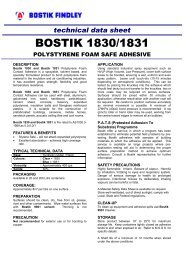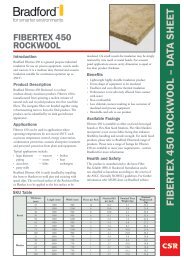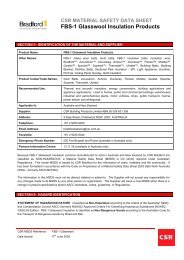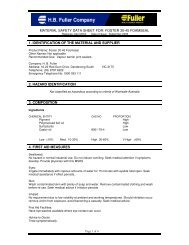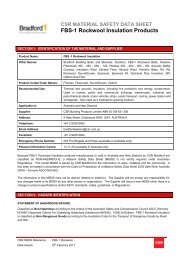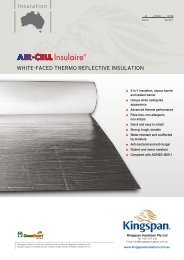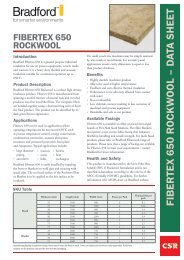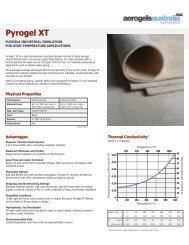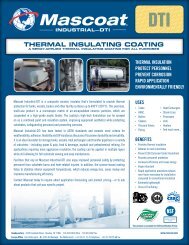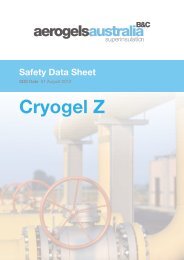Material Safety Data Sheet - Insulation Industries
Material Safety Data Sheet - Insulation Industries
Material Safety Data Sheet - Insulation Industries
You also want an ePaper? Increase the reach of your titles
YUMPU automatically turns print PDFs into web optimized ePapers that Google loves.
<strong>Material</strong> <strong>Safety</strong> <strong>Data</strong> <strong>Sheet</strong> AUSTHANE ECOISO-GP ISOCYANATE Page 4 of 6<br />
9. PHYSICAL AND CHEMICAL PROPERTIES<br />
Appearance Clear dark amber liquid<br />
Odour<br />
Mild musty odour<br />
pH<br />
Not applicable<br />
Vapour Pressure < 0.01 Pascals (25°C)<br />
Vapour Density > 1<br />
[Air = 1]<br />
Melting Point < 0°C<br />
Boiling Point 200°C @ 1 atm<br />
Solubility in Water Insoluble – reacts slowly with water<br />
Solubility in Slightly soluble<br />
Organic Solvents<br />
Specific Gravity 1.22 g/ml (25°C)<br />
[Water = 1]<br />
Flashpoint > 204°C (DIN 51758)<br />
Ignition Temperature > 600°C<br />
Flammability Non flammable<br />
10. STABILITY AND REACTIVITY<br />
Stability Stable. Thermal decomposition > 230°C<br />
Hazardous<br />
Polymerisation<br />
<strong>Material</strong>s to Avoid<br />
Hazards from<br />
Combustion<br />
Products<br />
Exothermic reaction with amines and alcohols. Reacts with water forming Carbon<br />
Dioxide gas, if in closed containers this may cause sufficient pressure build-up to burst<br />
containers.<br />
Water, acids, alkalis, alcohols, and metal compounds. Avoid water as it reacts to form<br />
heat and carbon dioxide. Enough heat and pressure can be produced to rupture a<br />
closed container. The reaction with water is slow at temperatures less than 49 o C, but<br />
accelerated at higher temperature and in the presence of the above mentioned<br />
materials. Some reactions are violent.<br />
Produces oxides of carbon and nitrogen on combustion. May produce traces of hydrogen<br />
cyanide. May decompose in heat/fire releasing products of greater hazard.<br />
11. TOXICOLOGICAL INFORMATION<br />
Inhalation<br />
Ingestion<br />
Skin<br />
Eye<br />
Chronic Effects<br />
continued next page<br />
MDI concentrations below the exposure standards may cause allergic respiratory reactions<br />
in individuals already sensitised. Symptoms may include coughing, difficult breathing and a<br />
feeling of tightness in the chest. Effects may be delayed.<br />
LC 50 inhalation, rat 490 mg aerosol / m³, 4 hr exposure. Concentration of the saturated<br />
vapour of Diphenylmethane-4,4-diisocyanate (MDI0 @ 25°C – 0.09 mg/m³.<br />
Ingestion of this product causes vomiting, nausea and abdominal pain.<br />
Single dose oral toxicity is considered to be extremely low.<br />
No hazards anticipated from swallowing small amounts incidental to normal handling<br />
operations.<br />
LD 50 oral / rat - > 10,000 mg/kg<br />
Prolonged or repeated exposure may cause skin irritation. May stain the skin. Skin contact<br />
may result in allergic skin reactions or respiratory sensitisation but is not expected to result<br />
in absorption of amounts sufficient to cause other adverse effects.<br />
LD 50 dermal / rabbits > 5,000 mg/kg.<br />
May cause slight transient (temporary) eye irritation. Corneal injury is unlikely.<br />
Systemic (Other Target Organ) Effects<br />
Tissue injury in the upper respiratory tract and lungs has been observed in laboratory<br />
animals after repeated excessive exposures to MDI / Polymeric, MDI aerosols.



